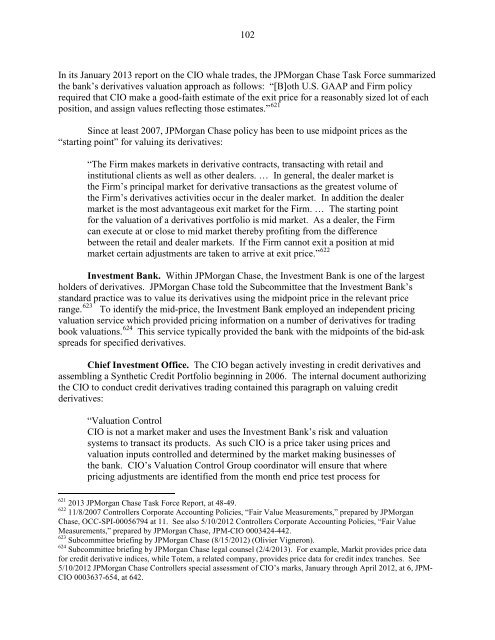JPMORGAN CHASE WHALE TRADES: A CASE HISTORY OF DERIVATIVES RISKS AND ABUSES
JPMORGAN CHASE WHALE TRADES: A CASE HISTORY OF DERIVATIVES RISKS AND ABUSES
JPMORGAN CHASE WHALE TRADES: A CASE HISTORY OF DERIVATIVES RISKS AND ABUSES
Create successful ePaper yourself
Turn your PDF publications into a flip-book with our unique Google optimized e-Paper software.
102<br />
In its January 2013 report on the CIO whale trades, the JPMorgan Chase Task Force summarized<br />
the bank’s derivatives valuation approach as follows: “[B]oth U.S. GAAP and Firm policy<br />
required that CIO make a good-faith estimate of the exit price for a reasonably sized lot of each<br />
position, and assign values reflecting those estimates.” 621<br />
Since at least 2007, JPMorgan Chase policy has been to use midpoint prices as the<br />
“starting point” for valuing its derivatives:<br />
“The Firm makes markets in derivative contracts, transacting with retail and<br />
institutional clients as well as other dealers. … In general, the dealer market is<br />
the Firm’s principal market for derivative transactions as the greatest volume of<br />
the Firm’s derivatives activities occur in the dealer market. In addition the dealer<br />
market is the most advantageous exit market for the Firm. … The starting point<br />
for the valuation of a derivatives portfolio is mid market. As a dealer, the Firm<br />
can execute at or close to mid market thereby profiting from the difference<br />
between the retail and dealer markets. If the Firm cannot exit a position at mid<br />
market certain adjustments are taken to arrive at exit price.” 622<br />
Investment Bank. Within JPMorgan Chase, the Investment Bank is one of the largest<br />
holders of derivatives. JPMorgan Chase told the Subcommittee that the Investment Bank’s<br />
standard practice was to value its derivatives using the midpoint price in the relevant price<br />
range. 623 To identify the mid-price, the Investment Bank employed an independent pricing<br />
valuation service which provided pricing information on a number of derivatives for trading<br />
book valuations. 624<br />
This service typically provided the bank with the midpoints of the bid-ask<br />
spreads for specified derivatives.<br />
Chief Investment Office. The CIO began actively investing in credit derivatives and<br />
assembling a Synthetic Credit Portfolio beginning in 2006. The internal document authorizing<br />
the CIO to conduct credit derivatives trading contained this paragraph on valuing credit<br />
derivatives:<br />
“Valuation Control<br />
CIO is not a market maker and uses the Investment Bank’s risk and valuation<br />
systems to transact its products. As such CIO is a price taker using prices and<br />
valuation inputs controlled and determined by the market making businesses of<br />
the bank. CIO’s Valuation Control Group coordinator will ensure that where<br />
pricing adjustments are identified from the month end price test process for<br />
621 2013 JPMorgan Chase Task Force Report, at 48-49.<br />
622 11/8/2007 Controllers Corporate Accounting Policies, “Fair Value Measurements,” prepared by JPMorgan<br />
Chase, OCC-SPI-00056794 at 11. See also 5/10/2012 Controllers Corporate Accounting Policies, “Fair Value<br />
Measurements,” prepared by JPMorgan Chase, JPM-CIO 0003424-442.<br />
623 Subcommittee briefing by JPMorgan Chase (8/15/2012) (Olivier Vigneron).<br />
624 Subcommittee briefing by JPMorgan Chase legal counsel (2/4/2013). For example, Markit provides price data<br />
for credit derivative indices, while Totem, a related company, provides price data for credit index tranches. See<br />
5/10/2012 JPMorgan Chase Controllers special assessment of CIO’s marks, January through April 2012, at 6, JPM-<br />
CIO 0003637-654, at 642.



